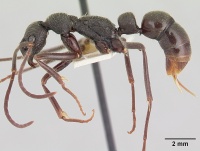Leptogenys bifida
| Leptogenys bifida | |
|---|---|

| |
| Scientific classification | |
| Kingdom: | Animalia |
| Phylum: | Arthropoda |
| Class: | Insecta |
| Order: | Hymenoptera |
| Family: | Formicidae |
| Subfamily: | Ponerinae |
| Tribe: | Ponerini |
| Genus: | Leptogenys |
| Species group: | elongata |
| Species: | L. bifida |
| Binomial name | |
| Leptogenys bifida Lattke, 2011 | |
The type specimens were collected from forest litter.
Identification
Lattke (2011) - Eye prominent and bulging, placed close to cephalic mid-length; apex of median clypeal lobe bidentate; mandible widest apicad; mesonotum and propodeal dorsum transversely strigulose.
The bidentate apex of the median clypeal lobe is unique amongst New World Leptogenys, making this large species easy to determine.
A member of the elongata species group.
Keys including this Species
Distribution
Distribution based on Regional Taxon Lists
Neotropical Region: Honduras (type locality).
Distribution based on AntMaps
Distribution based on AntWeb specimens
Check data from AntWeb
Countries Occupied
| Number of countries occupied by this species based on AntWiki Regional Taxon Lists. In general, fewer countries occupied indicates a narrower range, while more countries indicates a more widespread species. |

|
Estimated Abundance
| Relative abundance based on number of AntMaps records per species (this species within the purple bar). Fewer records (to the left) indicates a less abundant/encountered species while more records (to the right) indicates more abundant/encountered species. |

|
Biology
|
Castes
Queen, male. Unknown.
Nomenclature
The following information is derived from Barry Bolton's Online Catalogue of the Ants of the World.
- bifida. Leptogenys bifida Lattke, 2011: 155, fig. 13 (w.) HONDURAS.
Unless otherwise noted the text for the remainder of this section is reported from the publication that includes the original description.
Description
Worker
Metrics, holotype (paratypes, n = 2): HL 2.20 (2.20-2.35); HW 1.90 (1.85-1.95); ML 1.45 (1.45-1.50); EL 0.45 (0.45-0.45); SL 2.80 (2.75-2.90); PW 1.50 (1.50-1.55); WL 4.05 (4.00-4.20); PH 1.10 (1.05-1.40); PL 1.25 (1.20-1.30); DPW 0.95 (0.90-1.00) mm. CI 0.86 (0.83-0.84); MI 0.76 (0.77-0.78); OI 0.24 (0.23-0.24); SI 1.47 (1.49-1.49); LPI 0.88 (0.88-1.08); DPI 0.76 (0.75-0.77).
Head in full-face view wider anterad than posterad, posterior margin convex, occipital carina visible; lateral margin broadly convex, almost straight; median clypeal lobe ending in two blunt diverging teeth, lateral clypeal lobe modest, slightly sinuate. Transverse sulcus present from tentorial pit to antennal sclerite. Clypeus strigulose; head mostly longitudinally rugulose posterad of antennal insertions, becoming rugulose-punctate on frons, rugulae finer and more transverse towards vertex. Eye semispherical, dorsolaterally placed on head close to mid distance of lateral cephalic margin. Cephalic ventrum has anteriorly converging carinae. Scape surpasses posterior cephalic border by almost one-half its length; third antennal segment almost twice the length of second and longer than combined lengths of fourth and fifth. Mandible separates from clypeus at insertion, gap progressively wider towards mandibular apex, mandible widest apicad; masticatory margin edentate except for apical tooth; dorsal surface mostly smooth with sparse piligerous punctae and faint longitudinal strigulae.
Mesosoma with dorsal pronotal margin forming single convexity in lateral view; mesonotum distinct and broadly convex, metanotal groove deep; propodeal dorsum forms convexity more than twice the length of declivity; low triangular tooth present just above bulla. Pronotum with longitudinal strigulae in lateral view; strigulae curving around anterior pronotal face, pronotal disc with longitudinal strigulae; pronotum distinct, wider than long; propodeal declivitous face transversely strigulose, lateral margins rounded. Mesopleuron rugulose, with anteroventral laterally projecting lobe; meso-metapleural groove distinct, metapleural propodeal suture indistinct; propodeal spiracle elongate, surrounded by sulcus.
Petiole subquadrate in lateral view; anterior margin mostly straight to convex with brief basal convexity, dorsal margin convex to straight, posterior margin broadly convex, almost straight. Laterally rugulose on dorsal half, ventral half of lateral face tending to smooth with longitudinal strigulae. Node sub-rectangular in dorsal view, anterior margin almost as wide as posterior margin. Gaster shining, with abundant piligerous punctulae each separated from each other by a distance similar to their diameter. Head, mesosoma, and node black; gaster dark brown; mandible, antennae, and legs dark brown; body with standing pilosity, scape with abundant decumbent pilosity and scattered decumbent hairs, none standing.
Type Material
Holotype worker. Honduras, 14 km S La Ceiba, forest litter, G.V. Manley, 1979. Deposited in MCZC. – Paratypes. Two point-mounted workers with the same data as the holotype, one worker has a pupal cocoon glued on the same point. Deposited in Museum of Comparative Zoology.
Etymology
The species name alludes to the bidentate apex of the median clypeal lobe. It is derived from the Latin for bifurcate, bifidus.
References
- [[Media: Lattke 2011.pdf|Lattke, J.E. 2011. Revision of the New World species of the genus Leptogenys Roger (Insecta: Hymenoptera: Formicidae: Ponerinae). Arthropod Systematics & Phylogeny. 69:1*Wetterer, J. 2015. Geographic distribution of Leptogenys elongata (Buckley) and Leptogenys manni Wheeler (Hymenoptera, Formicidae, Ponerinae). Journal of Hymenoptera Research 46, 127–136 (doi:10.3897/jhr.46.6555).
27-264.]]

